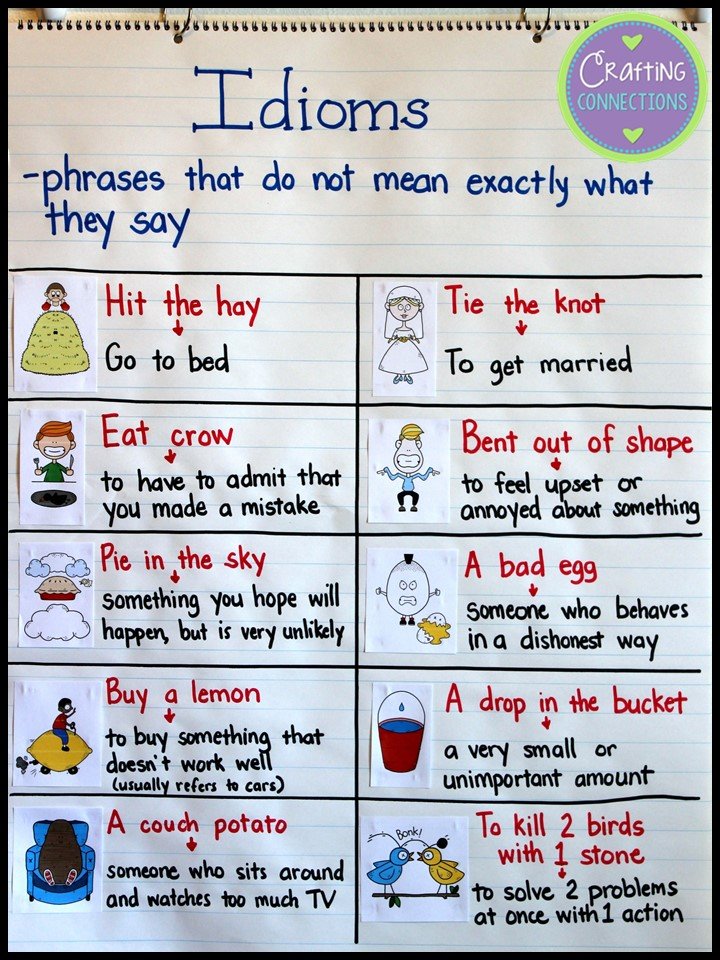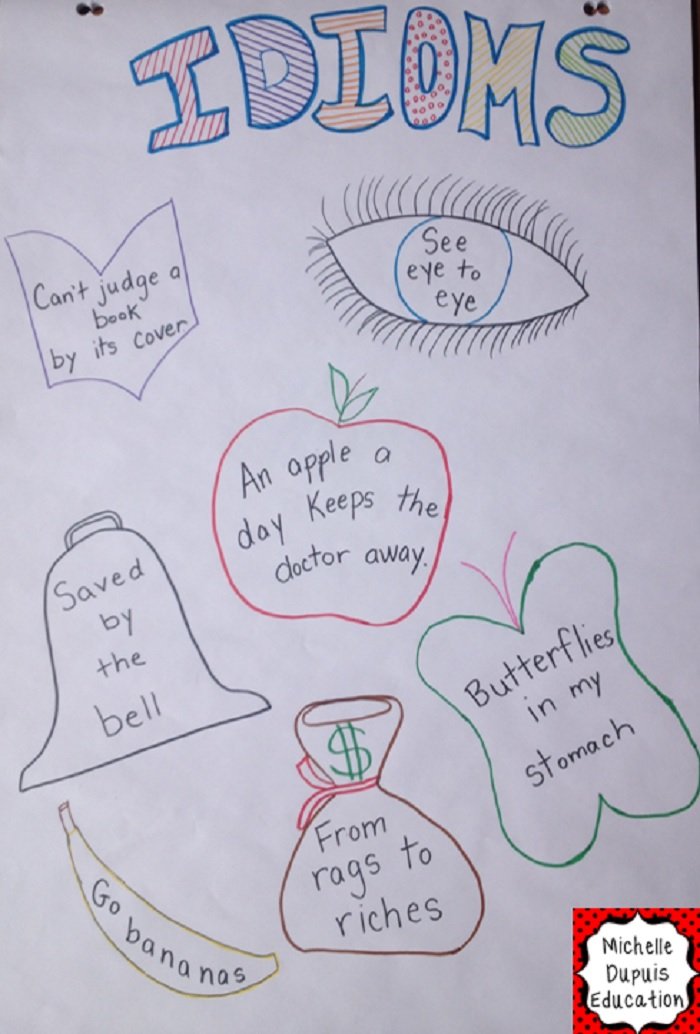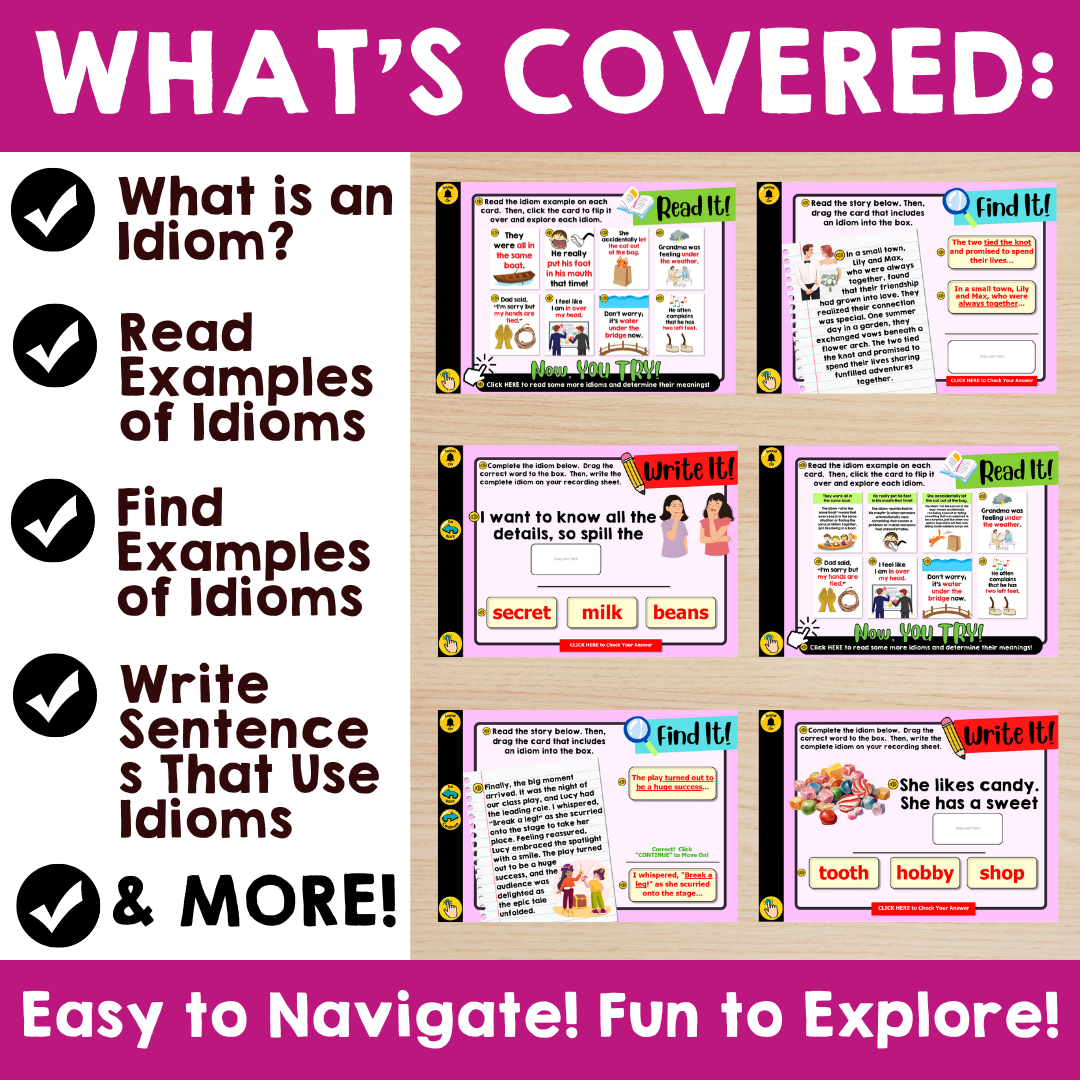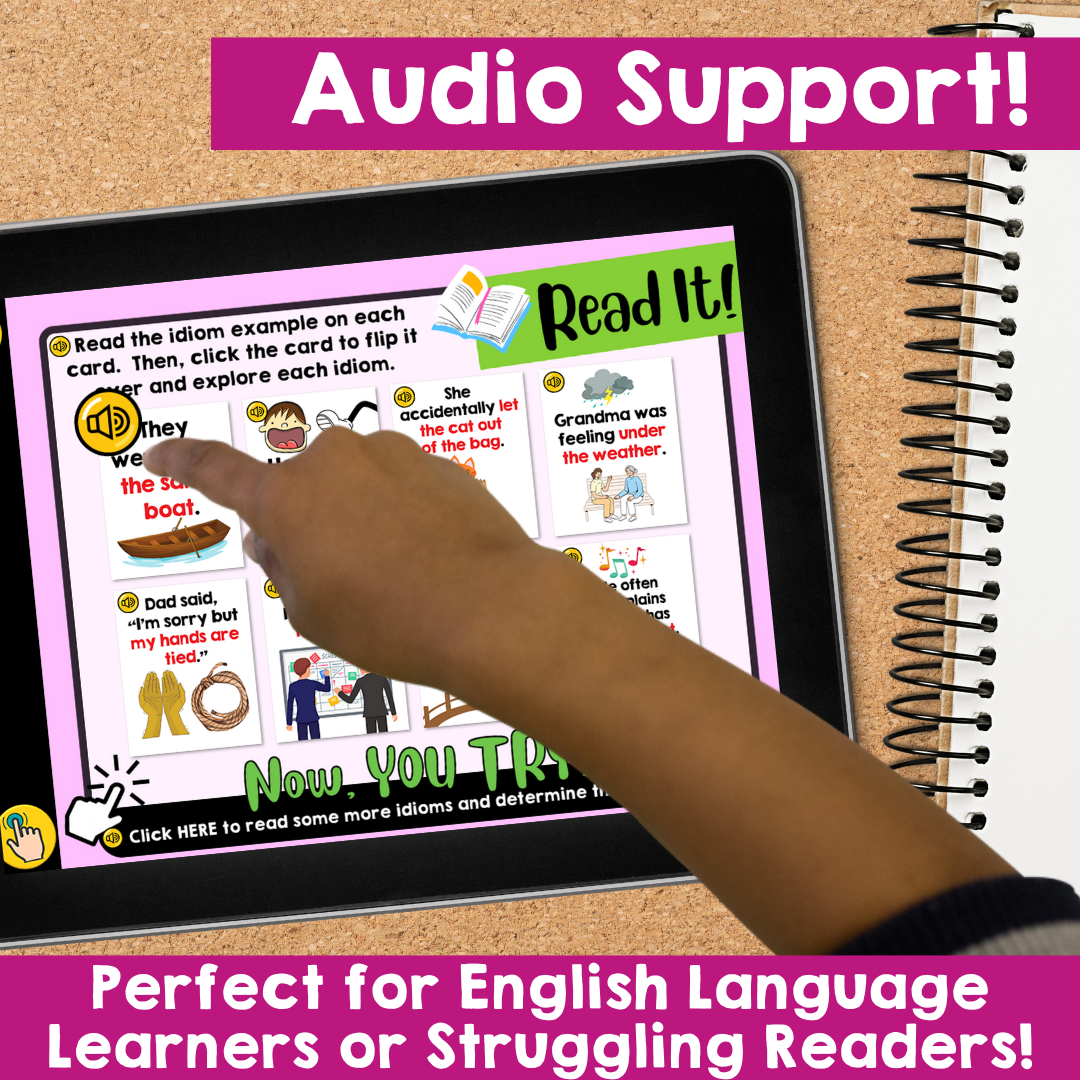Mastering Figurative Language: Fun Idiom Lessons & Activities for Kids
If you've ever wondered how to make learning idioms a breeze for your upper elementary students, you're in the right place.
Idioms, those quirky expressions that add color to our language, can sometimes be a puzzling aspect of English for young learners.
In this post, we'll dive into understanding idioms, explore the benefits of teaching them, and unveil a treasure trove of mini-lessons, engaging activities, and creative resources to introduce, practice, and master idiomatic expressions.
Get ready to learn how to help your students cracking the code of idioms with excitement and confidence!
If you’ve been following along, you’ll note that this post is part of a 6-part series all about how to teach figurative language to your students. We’re tackling each figure of speech one by one so that you can walk away with tips and tools for your third, fourth, or fifth graders!
Other Posts in This Series:
From A to Z: Alliteration Made Easy (Step-by-Step Teaching Strategies)
Hyperbole Lessons & Activities That Will Make Your Class Roar with Laughter
Exploring Figurative Language: Fun Strategies to Teach Personification to Elementary Students
Engage, Learn, and Create: Exciting Onomatopoeia Activities for Kids
Understanding Idioms
Idioms are colorful expressions in language that go beyond their literal meanings. They often convey a figurative or metaphorical message, adding depth and imagery to communication. For example, when someone says, "It's raining cats and dogs," they don't mean actual animals are falling from the sky; rather, they're expressing that it's raining heavily.
Why Idioms Can Be Challenging for Young Learners
Idioms can be tricky for young learners because they require understanding the context and cultural nuances behind them. Since idioms don't always make literal sense, students need to grasp the figurative meanings and how they're used in specific situations. This can be a cognitive leap for many learners, especially those who are still developing their language skills.
Examples of Common Idioms and Their Meanings
"Break a leg": This idiom doesn't mean to actually break a leg; it's a way to wish someone good luck.
"Hit the books": This idiom means to study or focus on academic work.
"Cost an arm and a leg": This idiom expresses that something is very expensive, not that body parts are being traded for it.
"Piece of cake": This idiom means something is very easy to do, not literally related to cake.
"Bite the bullet": This idiom means to face a difficult situation bravely, not to actually bite anything.
By providing concrete examples like these, students can start grasping the concept of idioms and begin navigating their figurative meanings with more confidence and understanding.
Benefits of Teaching Idioms
Teaching idioms offers a plethora of cognitive and linguistic advantages for young learners. By understanding and using idiomatic expressions, students:
Develop critical thinking skills as they decipher figurative meanings.
Enhance their vocabulary by learning new idiomatic phrases.
Improve comprehension skills by grasping nuanced language usage.
Strengthen their ability to interpret context and infer meanings in conversation and texts.
Boost their overall language proficiency, including listening, speaking, reading, and writing skills.
Contribution to Cultural Understanding and Communication Skills
Idioms are not just linguistic quirks; they are windows into cultural nuances and societal expressions. By teaching idioms, educators:
Foster cultural awareness and appreciation among students.
Encourage discussions about cultural diversity and the origins of idiomatic expressions.
Enhance students' ability to understand and empathize with different perspectives and experiences.
Promote effective communication by teaching idioms' appropriate usage in various social and professional contexts.
Equip students with valuable language tools for engaging in meaningful conversations and expressing ideas creatively.
In essence, teaching idioms goes beyond language mastery; it cultivates well-rounded individuals who can navigate language intricacies with cultural sensitivity and effective communication skills.
FREE POSTERS
Snag this FREE set of 7 posters to display in your classroom as you teach about types of figurative language.
Mini-lessons & Activities to Introduce Idioms:
Whole-Class Mini-Lesson
To begin teaching idioms effectively, start by exposing students to common idioms used in everyday conversations. Many students may have heard these idioms before without fully understanding their meanings.
In a whole-class mini lesson, organize students into small groups of 3-4. Provide each group with a card containing an idiom phrase.
Examples of these phrases include:
That test was a piece of cake!
Break a leg at your recital!
Those shoes cost an arm and a leg!
Hold your horses! We'll leave in a few minutes.
There's no use crying over spilled milk!
After a long day, I'm ready to hit the hay.
The old computer finally kicked the bucket.
Playing a game is a good way to break the ice at a party.
Instruct students to read their cards, paying attention to the underlined text, reflect on whether they've encountered this phrase before, and discuss potential meanings. This initial discussion will help students begin to understand the role idioms play in language and communication.
Create an anchor chart
To make the concept of idioms more tangible and engaging for elementary students, using an anchor chart can be incredibly effective.
When introducing idioms, create an anchor chart with a clear definition of idioms at the center. Surround this definition with examples and illustrations that demonstrate how idiomatic phrases convey figurative meanings in both literature and everyday language. This visual representation helps students understand the concept and encourages active participation in discussions.
These teacher-created anchor charts can serve as inspiration for creating your own.
MENTOR TEXTS, Poetry, and Songs for Teaching Idioms
What better way to show students how to identify and use idioms than to explore mentor texts that actually use them!?
These texts, which can include books, poems, and song lyrics, offer students opportunities to explore idioms within authentic language usage.
By analyzing mentor texts, students can not only learn the meanings of idioms but also understand how they are used effectively to convey specific messages, evoke emotions, and enhance the richness of language. Additionally, mentor texts allow students to see idioms in various genres and styles, broadening their exposure and comprehension of figurative language.
Teachers can use mentor texts as springboards for discussions, activities, and writing tasks that encourage students to identify, interpret, and creatively use idioms, thus deepening their understanding and mastery of figurative language skills.
Here are a few texts to get you started on your exploration. Look for them in your school or local libraries, or click on the links below to find them on Amazon.com (affiliate links)
MEntor Texts
There’s a Frog in My Throat by Pat Street
Life is a Bowl Full of Cherries by Vanita Oelschlager
It’s Raining Cats and Dogs by M. Drew
The World is Your Oyster by Tamara James
Reach for the Stars by Serge Bloch
My Momma Likes to Say by Denise Brennan-Nelson
Parts by Tedd Arnold
Poetry
"The Cat's Pajamas" by Shel Silverstein
"A Piece of Cake" by Kenn Nesbitt
"Row, Row, Row Your Boat" (Nursery Rhyme)
"Losing Pieces" by Shel Silverstein
Songs
🎵Bridge Over Troubled Water by Simon & Garfunkel
Like a bridge over troubled water
I will lay me down
🎵Hit the Road Jack by Ray Charles
Hit the road
🎵Don't Go Breaking My Heart by Elton John and Kiki Dee
Don't go breaking my heart
🎵Turn Back Time by Cher
If I could turn back time, if I could find a way
🎵Walking on Sunshine by Katrina and the Waves
I'm walking on sunshine
Here are different ways to effectively use these texts and gradually shift responsibility to your students:
Start with Read-Alouds and Collaborative Analysis: Begin by using mentor texts with onomatopoeia examples as read-alouds during your reading lessons. Engage the class in identifying onomatopoeic words within these texts. Create a class chart to highlight and discuss these examples, enhancing comprehension and involvement.
Move to Small Group Investigation: Provide small groups with mentor texts, poetry, or song lyrics containing onomatopoeia instances. Encourage students to work together to identify and analyze onomatopoeia in the given texts. This activity fosters teamwork, critical thinking, and a deeper understanding of onomatopoeia's use in literature.
Apply Learning through Independent Reading: Offer a selection of texts with onomatopoeia examples for students to explore during independent reading sessions. Encourage them to document the onomatopoeic words they discover using a graphic organizer or reading journal. This promotes independent exploration and reinforces the recognition and application of onomatopoeia in different contexts.
Engaging Activities to Practice Using Idioms
Exploring idioms with students can be an engaging and interactive adventure that ignites their creativity and language skills. Through a range of dynamic activities, students not only delve into the captivating realm of figurative expressions but also enhance their ability to convey meanings in a nuanced and expressive manner.
From interactive games to imaginative writing tasks and multimedia projects, these idiom activities provide educators with a myriad of opportunities to make learning enriching and enjoyable for your students. Let's delve into these exciting idiom activities that will have your students eagerly exploring the colorful language of idioms!
Idioms: I Have, Who Has…
This is an easy game to put together with all your favorite idioms (or, save time just and download this one for free from Cassie Dahl).
In case you haven’t played a “I have, Who Has” game before, here’s how it works.
Each student is given an idiom game card.
One student will have the “START” card. It could read something like this: “WHO HAS… the idiom that means “very easy.” All students would look at their card to see if they had the matching idiom. The student who has the card that says “I HAVE… a piece of cake” would stand up and read their card. That same student would then read their “who has” statement to keep the game going.
Each student has both an “I have…idiom phrase” and a “Who Has…meaning prompt” on their card (with the exception of the START and FINISH card holders) in order for the game to work its way through each student in the class.
The game continues until the student with the “FINISH” card reads the idiom on their card.
Idiom Memory Game (Literacy Center Activity)
Let's create a simple memory game using the same idioms from the "I Have, Who Has" literacy center game or choose new ones for variety.
In this game, some cards will display a common idiom, while other cards will show the matching meaning or a short passage using the idiom in context. This format allows for a fun and educational way for students to match idiomatic expressions with their meanings, enhancing their understanding of figurative language.
Idioms In the Wild
Encourage your students to keep idioms top of mind throughout the day with an engaging activity called the "Idioms in the Wild!" Set up a master chart titled "Idioms in the Wild" in your classroom, easily accessible to students.
Next to the chart, provide a stack of sticky notes and a marker. Instruct students to write down any idioms they encounter during the day, whether in conversations, videos, books, or other sources, on a sticky note. They should then place the sticky note on the chart.
This fun and simple challenge will prompt students to stay alert and aware of idioms in their everyday lives, fostering a deeper understanding and appreciation of figurative language.
Idiom LINKtivity®
Teachers have been raving about our LINKtivity series focused on figurative language. And our LINKtivity on Idioms has been a great addition to many literacy centers, morning work activities, and individual practice!
In our Idiom LINKtivity, students dive into a lively learning adventure where they can experience, listen to, and practice using idioms in different ways.
It begins with an engaging video that introduces and delves into the concept of idioms. You can use our idioms video (found right in the LINKtivity) to captivate students visually and audibly.
After watching the video, students participate in guided practice as they read, identify, and writing with idioms all within the LINKtivity platform.
This multimedia, interactive approach enhances their understanding and application of idiom in a digital learning environment.
Ready to get started with teaching idioms and other types of figurative language? Be sure to check out our entire series of Figurative Language LINKtivities!
Illustrated Idioms
One reason idioms are enjoyable and humorous is our tendency to imagine their literal meanings. This activity will be a hit with your students and provides a fantastic opportunity to link the reading skill of visualization with idioms.
Have students choose their favorite idiom and create an illustration to represent what it would like like from a literal sense.
VARIATIONS:
Play Pictionary
Turn this into a fun game by having students play Pictionary with idiom phrases. On students secretly picks an idiom and draws it for their group, prompting them to make a guess.
Make an Idiom Banner
Another fun way to display idiom illustrations is to create a class pennant banner. Provide each student with a pennant banner template for them to complete their idiom illustrations on (each student should have a different idiom). Then, connect each pennant piece together with string and hang it up in your classroom!
Idioms for The Classroom & Beyond!
Enhanced Language Skills: Engaging with idioms helps students expand their vocabulary, understand figurative language, and improve their overall language proficiency.
Cultural Appreciation: Exploring idioms from different cultures fosters cultural awareness and appreciation, promoting diversity and empathy among students.
Creative Expression: Using idiomatic expressions encourages students to think creatively, express themselves vividly, and add depth to their writing and communication.
Critical Thinking: Deciphering the meanings of idioms requires critical thinking skills, encouraging students to analyze context and infer meanings.
Confidence Boost: Mastering idioms gives students a sense of accomplishment and confidence in navigating complex language nuances.
Social Communication: Understanding idioms enhances students' ability to interpret and use language effectively in social interactions, improving communication skills.
















